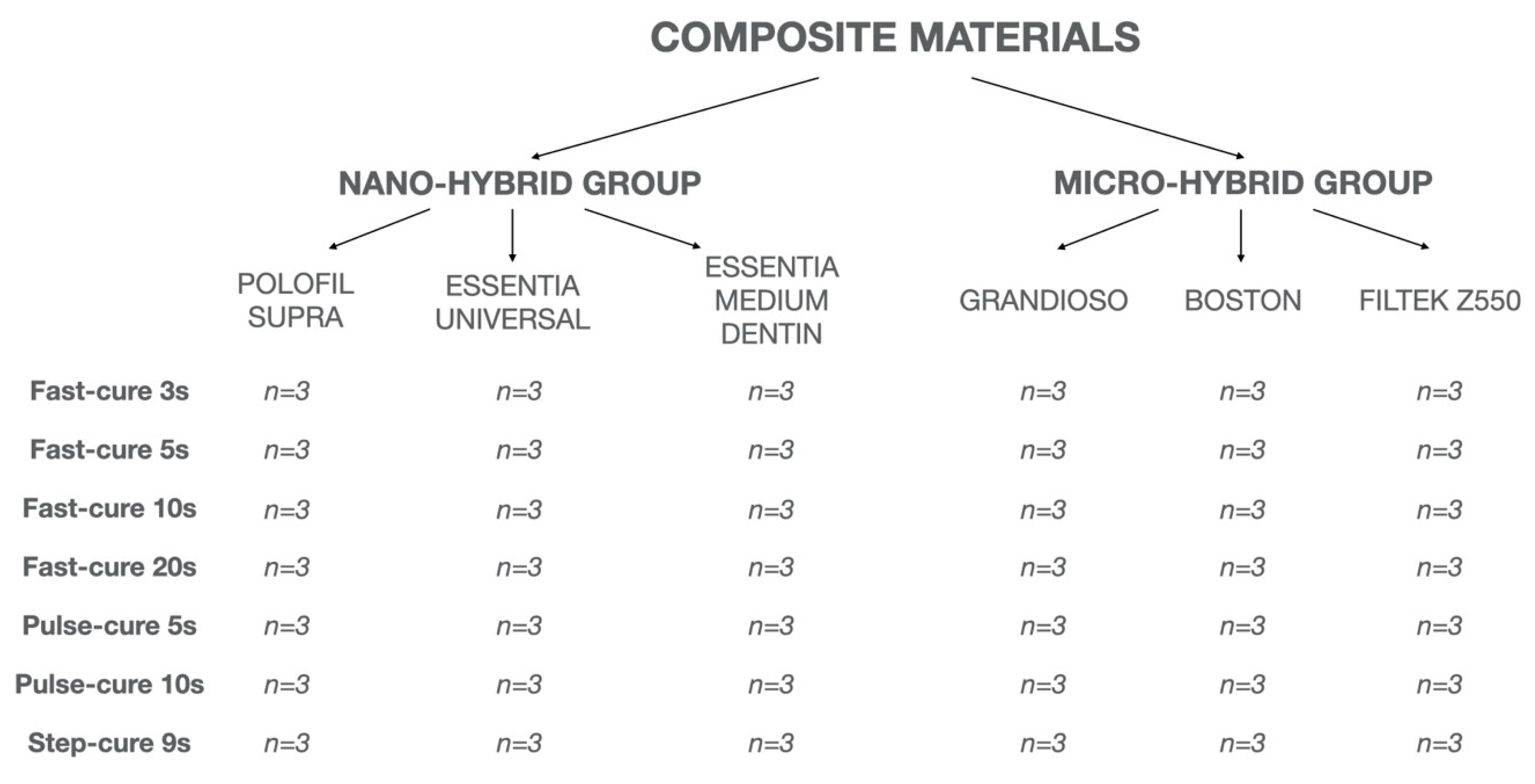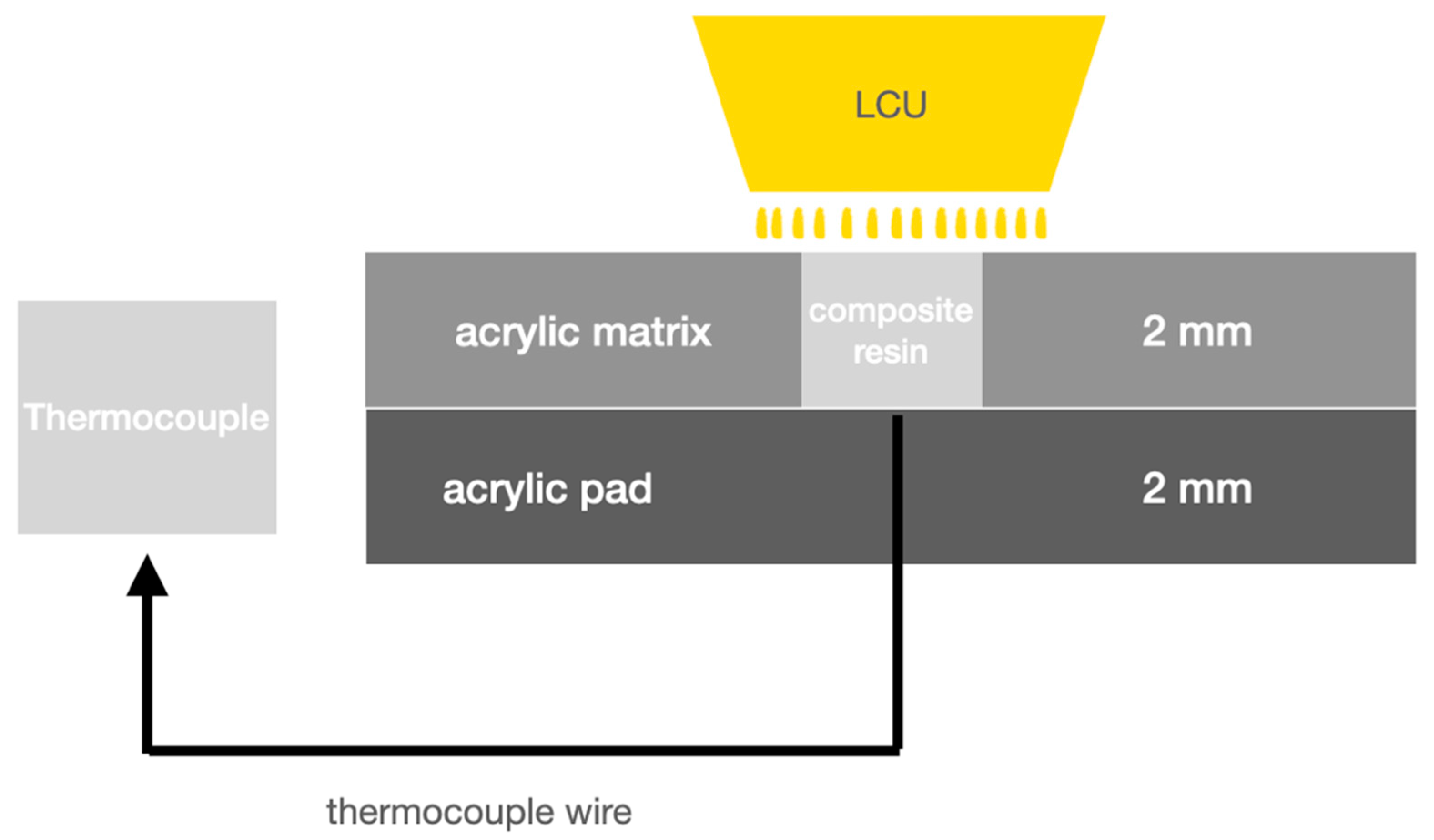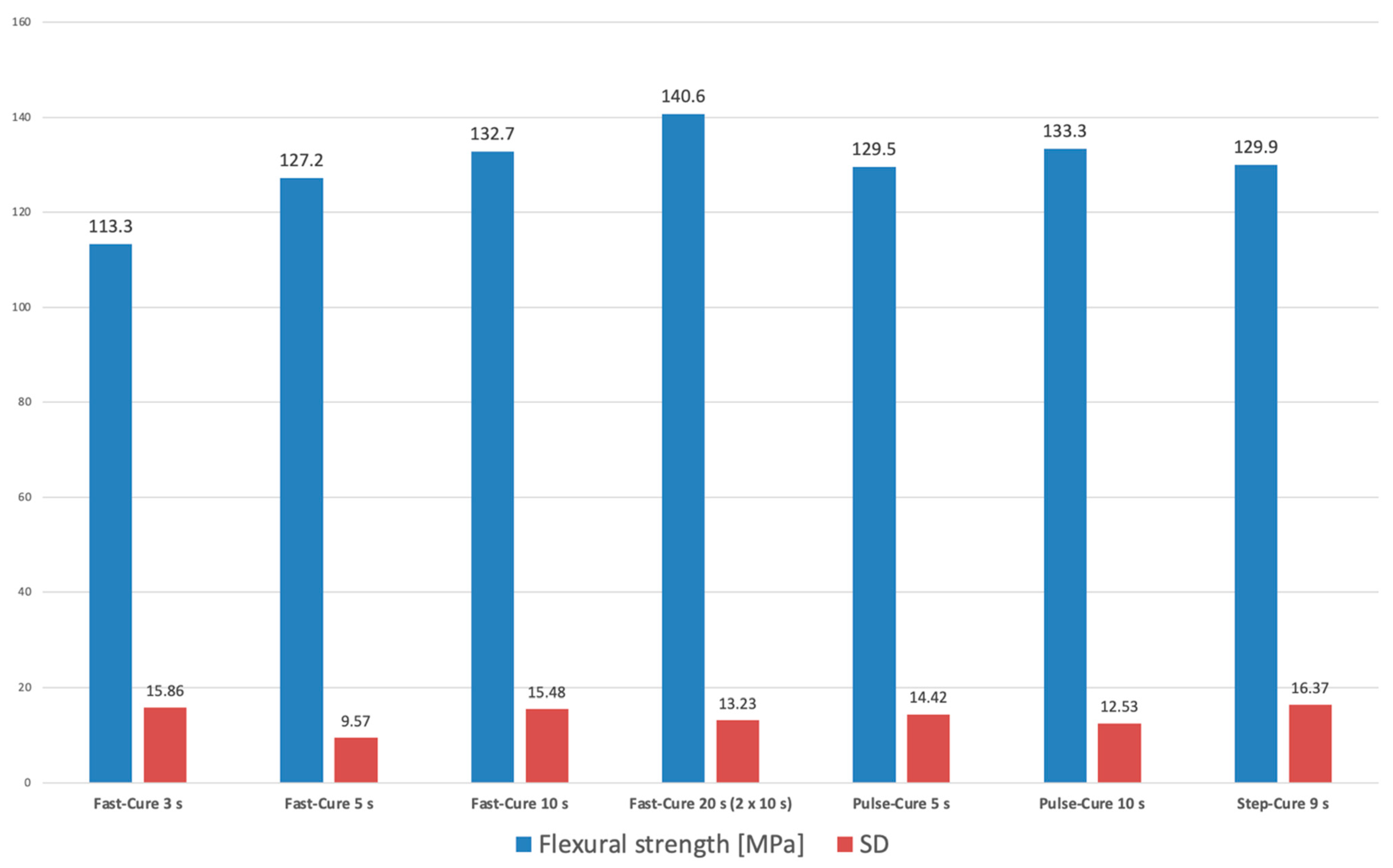Temperature Changes in Composite Materials during Photopolymerization
Abstract
1. Introduction
2. Materials and Methods
2.1. Composites
2.2. Light Curing Unit
2.3. Temperature Measurement
2.4. Flexural Strength Test
2.5. Statistical Analysis
3. Results
4. Discussion
5. Conclusions
- Short polymerization durations lead to lower temperature rise values, while extended polymerization durations increase the values to a critical temperature for pulp damage.
- The temperature rise was determined by polymerization durations rather than by the exposure mode used.
- The temperature rise varied according to the materials used.
- Sufficient flexural strength was obtained for all polymerization modes.
Author Contributions
Funding
Data Availability Statement
Conflicts of Interest
References
- Kopperud, S.E.; Rukke, H.V.; Kopperud, H.M.; Bruzell, E.M. Light curing procedures–performance, knowledge level and safety awareness among dentists. J. Dent. 2017, 58, 67–73. [Google Scholar] [CrossRef]
- Suliman, A.A.; Abdo, A.A.; Elmasmari, H.A. Training and experience effect on light-curing efficiency by dental practitioners: Training and experience effect on light-curing. J. Dent. Educ. 2020, 84, 652–659. [Google Scholar] [CrossRef] [PubMed]
- Zach, L.; Cohen, G. Pulp response to externally applied heat. Oral Surg. Oral Med. Oral Pathol. 1965, 19, 515–530. [Google Scholar] [CrossRef]
- Gross, D.J.; Dávila-Sánchez, A.; Runnacles, P.; Zarpellon, D.C.; Kiratcz, F.; Campagnoli, E.B.; Alegría-Acevedo, L.F.; Coelho, U.; Rueggeberg, F.A.; Arrais, C.A.G. In vivo temperature rise and acute inflammatory response in anesthetized human pulp tissue of premolars having Class V preparations after exposure to Polywave® LED light curing units. Dent. Mater. 2020, 36, 1201–1213. [Google Scholar] [CrossRef] [PubMed]
- Runnacles, P.; Arrais, C.A.G.; Pochapski, M.T.; dos Santos, F.A.; Coelho, U.; Gomes, J.C.; De Goes, M.F.; Gomes, O.M.M.; Rueggeberg, F.A. In vivo temperature rise in anesthetized human pulp during exposure to a polywave LED light curing unit. Dent. Mater. 2015, 31, 505–513. [Google Scholar] [CrossRef] [PubMed]
- Garrocho-Rangel, A.; Esparza-Villalpando, V.; Pozos-Guillen, A. Outcomes of direct pulp capping in vital primary teeth with cariously and non-cariously exposed pulp: A systematic review. Int. J. Paediatr. Dent. 2020, 30, 536–546. [Google Scholar] [CrossRef] [PubMed]
- Cervino, G.; Laino, L.; D’Amico, C.; Russo, D.; Nucci, L.; Amoroso, G.; Gorassini, F.; Tepedino, M.; Terranova, A.; Gambino, D.; et al. Mineral Trioxide Aggregate Applications in Endodontics: A Review. Eur. J. Dent. 2020, 14, 683–691. [Google Scholar] [CrossRef]
- Bjørndal, L.; Simon, S.; Tomson, P.L.; Duncan, H.F. Management of deep caries and the exposed pulp. Int. Endod. J. 2019, 52, 949–973. [Google Scholar] [CrossRef]
- Peutzfeldt, A.; Asmussen, E. Modulus of resilience as predictor for clinical wear of restorative resins. Dent. Mater. 1992, 8, 146–148. [Google Scholar] [CrossRef]
- Sideridou, I.D.; Karabela, M.M.; Vouvoudi, E.C. Physical properties of current dental nanohybrid and nanofill light-cured resin composites. Dent. Mater. 2011, 27, 598–607. [Google Scholar] [CrossRef]
- Ilie, N.; Stark, K. Effect of different curing protocols on the mechanical properties of low-viscosity bulk-fill composites. Clin. Oral Investig. 2015, 19, 271–279. [Google Scholar] [CrossRef] [PubMed]
- Aljosa, I.; Tijana, L.; Larisa, B.; Marko, V. Influence of Light-curing Mode on the Mechanical Properties of Dental Resin Nanocomposites. Procedia Eng. 2014, 69, 921–930. [Google Scholar] [CrossRef]
- Catelan, A.; Santo, M.R.d.E.; Menegazzo, L.M.; Moraes, J.C.S.; dos Santos, P.H. Effect of light curing modes on mechanical properties of direct and indirect composites. Acta Odontol. Scand. 2013, 71, 697–702. [Google Scholar] [CrossRef] [PubMed]
- Akiba, S.; Takamizawa, T.; Tsujimoto, A.; Moritake, N.; Ishii, R.; Barkmeier, W.W.; Latta, M.A.; Miyazaki, M. Influence of different curing modes on flexural properties, fracture toughness, and wear behavior of dual-cure provisional resin-based composites. Dent. Mater. J. 2019, 38, 728–737. [Google Scholar] [CrossRef] [PubMed]
- Ajaj, R.; Yousef, M.; Abo El Naga, A. Effect of different curing modes on the degree of conversion and the microhardness of different composite restorations. Dent Hypotheses 2015, 6, 109. [Google Scholar] [CrossRef]
- Khaksaran, N.K.; Kashi, T.J.; Rakhshan, V.; Zeynolabedin, Z.S.; Bagheri, H. Kinetics of pulpal temperature rise during light curing of 6 bonding agents from different generations, using light emitting diode and quartz-tungsten-halogen units: An in-vitro simulation. Dent. Res. J. (Isfahan) 2015, 12, 173–180. [Google Scholar]
- Jo, S.-A.; Lee, C.-H.; Kim, M.-J.; Ferracane, J.; Lee, I.-B. Effect of pulse-width-modulated LED light on the temperature change of composite in tooth cavities. Dent. Mater. 2019, 35, 554–563. [Google Scholar] [CrossRef]
- Braga, S.; Oliveira, L.; Ribeiro, M.; Vilela, A.; da Silva, G.; Price, R.; Soares, C. Effect of Simulated Pulpal Microcirculation on Temperature When Light Curing Bulk Fill Composites. Oper. Dent. 2019, 44, 289–301. [Google Scholar] [CrossRef]
- Kim, R.J.-Y.; Lee, I.-B.; Yoo, J.-Y.; Park, S.-J.; Kim, S.-Y.; Yi, Y.-A.; Hwang, J.-Y.; Seo, D.-G. Real-Time Analysis of Temperature Changes in Composite Increments and Pulp Chamber during Photopolymerization. BioMed Res. Int. 2015, 2015, 1–6. [Google Scholar] [CrossRef]
- Hubbezoglu, I.; Dogan, A.; Dogan, O.M.; Bolayir, G.; Bek, B. Effects of Light Curing Modes and Resin Composites on Temperature Rise under Human Dentin: An in vitro Study. Dent. Mater. J. 2008, 27, 581–589. [Google Scholar] [CrossRef][Green Version]
- Schneider, L.F.; Consani, S.; Correr-Sobrinho, L.; Correr, A.B.; Sinhoreti, M.A. Halogen and LED light curing of composite: Temperature increase and Knoop hardness. Clin. Oral Investig. 2006, 10, 66–71. [Google Scholar] [CrossRef] [PubMed]
- Guenka Palma-Dibb, R.; Savaris, C.; Alexandra Chinelatti, M.; Augusto de Lima, F.; Bachmann, L.; Jendiroba Faraoni, J. Composite Photopolymerization: Temperature Increase According to Light Source and Dentin Thickness. JDOI 2016, 1, 11–19. [Google Scholar] [CrossRef]
- Santini, A.; Watterson, C.; Miletic, V. Temperature Rise Within the Pulp Chamber During Composite Resin Polymerisation Using Three Different Light Sources. TODENTJ 2008, 2, 137–141. [Google Scholar] [CrossRef] [PubMed]
- Bağiş, B.; Bagis, Y.; Ertas, E.; Ustaomer, S. Comparison of the Heat Generation of Light Curing Units. J. Contemp. Dent. Pract. 2008, 9, 65–72. [Google Scholar] [CrossRef]
- Pieniak, D.; Niewczas, A.M.; Walczak, M.; Zamościńska, J. Influence of photopolymerization parameters on the mechanical properties of polymer-ceramic composites applied in the conservative dentistry. Acta Bioeng. Biomech. 2014, 16, 29–35. [Google Scholar] [CrossRef]
- Da Silva, E.M.; Poskus, L.T.; Guimarães, J.G.A. Influence of Light-polymerization Modes on the Degree of Conversion and Mechanical Properties of Resin Composites: A Comparative Analysis Between a Hybrid and a Nanofilled Composite. Oper. Dent. 2008, 33, 287–293. [Google Scholar] [CrossRef]
- Witzel, M.F.; Calheiros, F.C.; Gonçalves, F.; Kawano, Y.; Braga, R.R. Influence of photoactivation method on conversion, mechanical properties, degradation in ethanol and contraction stress of resin-based materials. J. Dent. 2005, 33, 773–779. [Google Scholar] [CrossRef]
- Calheiros, F.; Kawano, Y.; Stansbury, J.; Braga, R. Influence of radiant exposure on contraction stress, degree of conversion and mechanical properties of resin composites. Dent. Mater. 2006, 22, 799–803. [Google Scholar] [CrossRef]



| Material | Manufacturer | Shade | Type | Filler Content % (w/w) | Filler Type | Particle Size | Matrix |
|---|---|---|---|---|---|---|---|
| Boston | Arkona LFS, Nasutów, Poland | A2 | nano-hybrid | 78% | barium-aluminium-silicon glass, fumed silica, titanium dioxide | 15 nm–2000 nm | Bis-GMA, UDMA, Bis-EMA, TEGDMA |
| Grandioso | Voco, Cuxhaven, Germany | A2 | nano-hybrid | 89% | glass ceramic filler; silicon dioxide nanoparticles | 60% of paticles: 20–40 nm | Bis-GMA, Bis-EMA, TEGDMA |
| Filtek Z550 | 3M ESPE, St Paul, MN, USA | A2 | nano-hybrid | 82% | surface modified zirconia/silica filler, non-agglomerated/non-aggregated surface-modified silica particles | 20–3000 nm | Bis-GMA, UDMA, Bis-EMA, PEGDMA, TEGDMA |
| Essentia | GC Corporation, Tokyo, Japan | Medium Dentin | micro-hybrid | 81% | prepolymerized fillers, barium glass, fumed silica | no data | Bis-GMA, UDMA Bis-MEPP, Bis-EMA, TEGDMA |
| Essentia | GC Corporation, Tokyo, Japan | Universal | micro-hybrid | 81% | prepolymerized fillers, barium glass, fumed silica | no data | Bis-GMA, UDMA Bis-MEPP, Bis-EMA, TEGDMA |
| Polofil Supra | Voco, Cuxhaven, Germany | A2 | micro-hybrid | 76.50% | Sintraglass multifillers | 50–2000 nm | Bis-GMA, UDMA, TEGDMA, HEMA |
| Model | Manufacturer | Wavelength Range | Central Wavelength | Intensity | Fast-Cure Mode | Pulse-Cure Mode | Step-Cure Mode |
|---|---|---|---|---|---|---|---|
| MINI LED III Supercharged | Acteon Group (Merignac, France) | 420–480 nm | 455–465 nm | 2000 mW/cm2 ± 10% for an active fiber diameter of 7.5 mm | Full power for 3/5/10 s | 5/10 shots of 1 s (full power with emission of 5/10 successive one second flashes with a rest of period of 250 ms between each flash) | 6 s progressively and 3 s at full power |
| Total energy: 3 s–6 J/cm2; 5 s–10 J/cm2; 10 s–20J/cm2; 20 s–40 J/cm2 | Total energy: 5 shots–10 J/cm2; 10 shots–20 J/cm2 | Total energy: 12 J/cm2 |
| Fast-Cure 3 s | Fast-Cure 5 s | Fast-Cure 10 s | Fast-Cure 20 s (2 × 10 s) | Pulse-Cure 5 s | Pulse-Cure 10 s | Step-Cure 9 s | ||||||||
|---|---|---|---|---|---|---|---|---|---|---|---|---|---|---|
| T0 | T1 | T0 | T1 | T0 | T1 | T0 | T1 | T0 | T1 | T0 | T1 | T0 | T1 | |
| BOSTON | 28.4 (0.3) | 36.0 (0.4) | 28.3 (0.4) | 41.5 (0.6) | 28.8 (0.2) | 45.7 (0.9) | 28.9 (0.3) | 46.7 (2.1) | 29.3 (0.1) | 42.4 (1.8) | 29.1 (0.2) | 44.8 (1.0) | 29.2 (0.1) | 45.7 (2.7) |
| GRANDIOSO | 28.6 (0.4) | 38.6 (0.8) | 28.4 (0.3) | 42.3 (1.6) | 29.0 (0.4) | 41.8 (1.4) | 29.5 (0.1) | 42.8 (0.6) | 29.6 (0.2) | 43.4 (1.3) | 29.7 (0.1) | 44.5 (2.0) | 29.8 (0.1) | 44.8 (0.4) |
| FILTEK Z550 | 29.5 (0.1) | 41.6 (1.6) | 29.7 (0.3) | 48.0 (2.5) | 29.8 (0.1) | 47.3 (1.4) | 29.9 (0.1) | 47.7 (1.8) | 29.0 (0.1) | 44.5 (1.3) | 29.8 (0.1) | 47.4 (1.8) | 29.1 (0.8) | 47.2 (1.1) |
| ESSENTIA MEDIUM DENTIN | 29.0 (0.1) | 36.3 (1.0) | 29.6 (0.2) | 42.8 (1.6) | 29.7 (0.1) | 45.2 (1.3) | 30 (0.5) | 45.3 (0.7) | 29.9 (0.1) | 43.9 (2.1) | 29.9 (0.2) | 43.3 (0.6) | 29.3 (0.3) | 46.1 (1.8) |
| ESSENTIA UNIVERSAL | 29.0 (0.2) | 41.2 (0.3) | 28.6 (0.1) | 42.6 (2.1) | 28.7 (0.2) | 43.7 (0.1) | 29.3 (0.3) | 46.5 (0.7) | 29.5 (0.1) | 43.3 (0.6) | 29.5 (0.3) | 44.6 (1.8) | 29.6 (0.2) | 43.8 (2.6) |
| POLOFIL SUPRA | 28.5 (0.2) | 41.1 (0.3) | 29.0 (0.2) | 46 (1.5) | 29.2 (0.2) | 47.3 (0.4) | 29.5 (0.1) | 46.7 (1.1) | 29.4 (0.2) | 44.6 (2.4) | 29.4 (0.1) | 45.9 (0.8) | 29.6 (0.2) | 45.5 (0.5) |
| TOTAL | 28.8 (0.45) | 39.0 (2.7) a | 28.9 (0.6) | 43.6 (3.0) a | 29.2 (0.5) | 45.0 (2.3) b | 29.4 (0.4) | 45.8 (2.0) b | 29.6 (0.2) | 43.3 (1.7) b | 29.6 (0.3) | 45.0 (1.9) b | 29.4 (0.4) | 45.2 (1.9) b |
| Response: dt | |||||
|---|---|---|---|---|---|
| Df | Sum Sq | Mean Sq | F value | Pr(>F) | |
| Filler | 1 | 52.00 | 52.001 | 2.2404 | 0.1371 |
| Polymerization time | 6 | 66.54 | 11.090 | 1.4778 | 0.3237 |
| Residuals | 118 | 2738.89 | 23.211 | ||
Publisher’s Note: MDPI stays neutral with regard to jurisdictional claims in published maps and institutional affiliations. |
© 2021 by the authors. Licensee MDPI, Basel, Switzerland. This article is an open access article distributed under the terms and conditions of the Creative Commons Attribution (CC BY) license (http://creativecommons.org/licenses/by/4.0/).
Share and Cite
Szalewski, L.; Szalewska, M.; Jarosz, P.; Woś, M.; Szymańska, J. Temperature Changes in Composite Materials during Photopolymerization. Appl. Sci. 2021, 11, 474. https://doi.org/10.3390/app11020474
Szalewski L, Szalewska M, Jarosz P, Woś M, Szymańska J. Temperature Changes in Composite Materials during Photopolymerization. Applied Sciences. 2021; 11(2):474. https://doi.org/10.3390/app11020474
Chicago/Turabian StyleSzalewski, Leszek, Magdalena Szalewska, Paweł Jarosz, Michał Woś, and Jolanta Szymańska. 2021. "Temperature Changes in Composite Materials during Photopolymerization" Applied Sciences 11, no. 2: 474. https://doi.org/10.3390/app11020474
APA StyleSzalewski, L., Szalewska, M., Jarosz, P., Woś, M., & Szymańska, J. (2021). Temperature Changes in Composite Materials during Photopolymerization. Applied Sciences, 11(2), 474. https://doi.org/10.3390/app11020474






